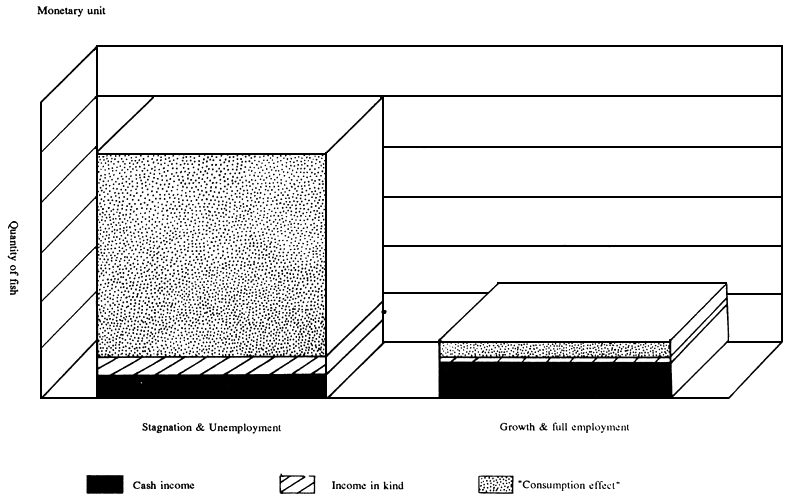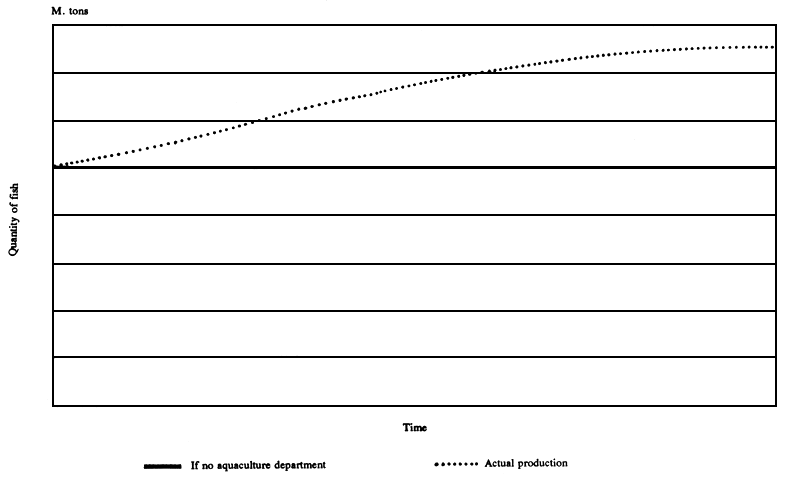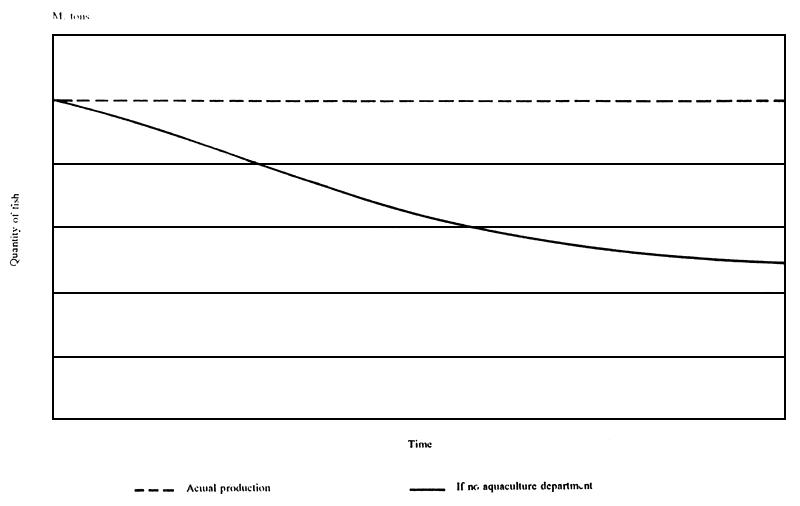There are two sides to government's support of rural fish farming: it generates wealth (income) and it withdraws wealth (disposable income) from the public at large. There must be a balance between these two effects.
The key question for Government is: What amount of tax revenue should be used to support tilapia, or more widely, fish culture?
The author is of the view that:
Not only should income in cash and in kind be considered as benefits but so should the “consumption effects”
Income should be evaluated and counted over as long a period as possible; and,
A low rate of discount should be used to convert these future incomes to income at the moment of analysis.
The inclusion of income in cash and in kind is not controversial. The inclusion (and discounting) of “consumption effects” may be.
“Consumption effects” should be least controversial where they are most obvious: in the stagnant rural economy with widespread underemployment. There can be little doubt that they do occur, and that even in a short period (through spending on medicines and tools) they may generate additional income several times the value of the original quantity of fish consumed or sold.
“Consumption effects” do of course also occur in the “full employment, growing economy” scenario. The difference is that in that situation the effects would occur also in the absence of fish culture, as the farmer (or farm-household member) would find other employment. It would thus be too much, in this economic context, to claim that they originate, to their full extent, in fish culture.
The author's view of the wealth generated by fish culture in the rural environment in southern Africa is displayed below in Figure 6.
Farmers' income from a kg of fish: a function of the rural economy

Note: the concept of “consumption effect” is explained in the text
The author argues for explicitly including amongst benefits the wealth generated a decade hence and even later. The reason is that in all likelihood the households concerned do not consider their income a decade from now as uninteresting. Neither should the government. It knows that it is absolutely essential to start economic growth. Growth is the only means by which misery for the rural population can be avoided in the long run.
Thus, although precise estimates cannot be made without reference to a precise situation, it is certain that the value today of constructing and using a fish pond in a stagnant economy is many times the fish produced in the space of one year.
From the standpoint of the economy as a whole, shifting income from the average citizen to the state is not in itself a cost. The funds placed at the disposal of the state, through its various services, will be returned (in the form of salaries and purchases of goods and services) to the population. Demand will be sustained in the economy.
Does this mean that from the standpoint of the national economy no costs could result from taxing the general citizen to fund a government service? No, very real costs may indeed be incurred. It all depends on how tax revenues are used. Costs would be incurred if staff, equipment and supplies used have not stimulated as much economic growth through fish culture as the same resources would have if allocated by Government to some other sector of the national economy.
Thus there are two parts to the argument: the magnitude of economic growth actually achieved through fish culture, and, the possible economic growth if the resources were reallocated. The author will not address the latter (growth in other parts of the economy) but will address the first part of the argument: the degree of growth achieved through fish farming.
The fisheries department can use two types of arguments: (i) “the production of cultured fish is growing - so we are using our government funds productively”; and/or (ii) “the production of farmed fish is not falling, which it would without our intervention”. The positive contribution, as argued previously, is made up of the production of those who come fresh to the activity and the increased production of those who are becoming more effective. The two basic arguments are illustrated in Figures 7 and 8 below.
Unfortunately, these claims cannot be verified by simple inspection. In each case it is a comparison of two trajectories only one of which possibly can occur; the other remains a hypothesis. Also, neither proves that the tax revenues when employed for support of rural fish farming, are as effective contributors to rural growth as they would be if dedicated to other branches of Government.
However, is it realistic to compare the actual contributions to economic growth with what could have been obtained elsewhere? Are the staff, equipment, infrastructure and services used movable?
We cannot argue that the resources must remain idle if not used in support of rural fish culture. That may be true for the fish culture stations, and even for some of the staff employed on them. But, it would not be correct when applied to the funds committed from the public treasury to pay salaries and recurrent inputs on the fish culture stations. Thus, the real costs could at least equal the value of the budgets allocated to fish culture stations, extension staff and a share of the directorate's budget.
In a stagnant economy, with widespread unemployment, there is ample justification for starting fish culture in an area where it is not being undertaken, as long as the basic preconditions (economic availability of land, water; fish consumption) exist. The long term benefits could be considerable9.
“We generate increased production”

“We prevent fall in production”

In areas where land and water have a cost, while under-employment prevails (high population density areas) the net wealth generated will be lower than in those areas where land and water are “free”. There will be correspondingly less justification for government to promote fish culture as a way to stimulate growth.
Both for the farmer and for the economy the production increase is equal to the difference between what he achieves with pond farming and what he would be achieving in the next best alternative. As the economy develops the difference is going to be increasingly marginal. Or, expressed in terms of a percentage of the market value of the fish produced; the percentage is going to drop.
Thus, the above analysis clearly indicates that as the economy approaches full employment and economic growth, the “margin” for public expenditure in support of aquaculture production is declining. It is declining as the amounts that can be afforded per kg of fish produced are declining rapidly (see Figure 6). Thus, as the economy goes from stagnation to growth and full employment, the quantity of tilapia “produced” per fish scout and year should increase for the “economic efficiency” of the fish scout to remain unchanged.
In a growing economy, with close to full employment, the main part of the benefits of fish culture (the consumption effects) would be small and therefore there would be a correspondingly smaller justification for spending tax revenue on stimulating new entrants. There is more and larger justification for stimulating existing fish culturists to improve their productivity.
9. Annex 5 discusses an approach to assessing the long-term benefits of rural fish culture.